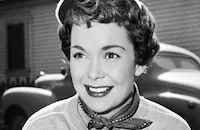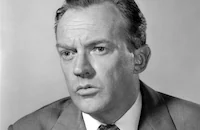The Glass Menagerie
Brief Synopsis
Cast & Crew
Irving Rapper
Jane Wyman
Kirk Douglas
Gertrude Lawrence
Arthur Kennedy
Ralph Sanford
Film Details
Technical Specs

Synopsis
During the early morning watch, Merchant Marine Tom Wingfield remembers his life in a shabby St. Louis apartment with his mother Amanda and crippled sister Laura: Although she must sell magazine subscriptions to supplement Tom's income from his work in a warehouse, Amanda fancies herself to be socially superior to their impoverished neighbors. She blames the family's reduced circumstances on her absent husband, "a telephone operator who fell in love with Long Distance," and abandoned the family years earlier. Afraid that Tom will also leave the family, she nags him to bring home one of his friends to meet, and hopefully court, the shy, lame Laura. At Amanda's urging, Laura is taking a secretarial course, but her only real interest is her collection of small glass animals. Tom dreams of escaping his squalid life and Amanda's romanticized memories of her genteel Southern girlhood. When Amanda learns that Laura has left the secretarial school, she proclaims that they will have to get her married. Laura reminds her mother that she is crippled, and Amanda angrily replies that she must not think of herself that way. One day, Tom invites his friend, Jim O'Connor, to dinner. Carried away by the possibilities of Laura's first "gentleman caller," Amanda imagines Laura married to Jim, and despite Tom's gentle caution that Laura's shyness makes her seem peculiar, Amanda makes elaborate preparations for the dinner. Laura, however, is distressed when she learns the name of their visitor, because she remembers him from high school as one of the most popular boys. She avoids dinner, claiming that she is too ill to eat, but later, when Amanda arranges for Laura to be alone with Jim, his open friendliness draws her out. Diagnosing her shyness as an inferiority complex, Jim persuades her to show him her glass collection and then coaxes her to dance. Laura's awkwardness causes them to accidentally break the horn off Laura's prize glass unicorn. Although she is upset at first, she is able to accept the change because it enables the unicorn to fit in with the horses in the collection. To Amanda's delight, Jim then asks Laura to go across the alley to the Paradise Ballroom. Again Jim encourages Laura to have more self-confidence, and after kissing her, explains that he is engaged to a woman named Betty. Amanda is more upset than Laura, who gives Jim the broken unicorn as a gift and invites him to visit again with Betty. Amanda takes out her disappointment on Tom, who storms out of the apartment. Laura follows him to voice her approval and love. Tom joins the Merchant Marine. Later, Laura has her own gentleman caller.

Director

Irving Rapper
Cast

Jane Wyman

Kirk Douglas

Gertrude Lawrence

Arthur Kennedy
Ralph Sanford
Ann Tyrrell
John Compton
Gertrude Graner
Sara Edwards
Louise Lorimer
Chris Alcaide
Perdita Chandler
Dick Bartell
Victor Desney
Peter Camlin
Philip Ahn
Marshall Romer
James Horne
Sean Mcclory
Crew
Milo Anderson
Peter Berneis
Robert Burks
Murray Cutter
Charles K. Feldman
David C. Gardner
Oliver S. Garretson
Robert Haas
Don Page
Max Steiner
Jerry Wald
William Wallace
David Weisbart
Perc Westmore
Tennessee Williams

Film Details
Technical Specs

Articles
Sean McClory (1924-2003)
Born on March 8, 1924 in Dublin, Ireland, he became a leading man at the famous Abbey Theatre in the early '40s and relocated to the United States shortly after World War II. His first roles were small bits as a police officer in two RKO quickies: Dick Tracy's Dilemma and Dick Tracy Meets Gruesome (both 1947). He eventually graduated to more prestigious pictures like The Glass Menagerie (1950), Les Miserables (1952) and John Ford's The Quiet Man (1952).
After a few more supporting roles in quality pictures: Niagara (1953); the sci-fi chiller Them! (1954); and for John Ford again in The Long Gay Line (1955), McClory turned to television. He kept busy for several years with guest roles in a variety of popular shows: Bonanza, Wagon Train, Rawhide, Gunsmoke, The Outer Limits (1964) and countless others. By the mid-'60s, McClory became slightly more heavy-set, and began tossing off variations of jovial, "oirish" blarney for, yet again John Ford in Cheyenne Autumn (1964); and in a string of Disney pictures: Follow Me, Boys! (1966, his best role, a moving performance as the alcoholic father whose behavior alienates his son, played by a 15-year old Kurt Russell); The Happiest Millionaire (1967), and The Gnome-Mobile (1967), before he returned to television. His final role was in John Huston's acclaimed Irish opus The Dead (1987). He is survived by his wife, Peggy Webber McClory.
by Michael T. Toole

Sean McClory (1924-2003)
Quotes
Trivia
Notes
Papers included in the Charles K. Feldman collection at the AFI Louis B. Mayer Library add the following information about the production: Feldman originally wanted Jeanne Crain to play the part of "Laura," and Ethel Barrymore was his first choice for the role of "Amanda." Feldman also considered Gene Tierney and Montgomery Clift for the film. Feldman intended to make the picture in Technicolor but was unable to get a commitment from the company. Norman Corwin wrote a script for the film, but none of his material was used in the final picture. The film was shot in 42 days for a total cost of $1,357,000.
According to March 3, 1949 Hollywood Reporter news item, Warner Bros. held discussions with Helen Hayes to play the part of "Amanda." An July 18, 1949 Hollywood Reporter news item reported that Feldman was negotiating with Marlon Brando, who had made a name for himself in Williams' play Streetcar Named Desire, to co-star in the film. According to a August 22, 1949 memo from New York studio executive Harry Mayer to studio executive Steve Trilling, reproduced in a modern source, Tallulah Bankhead, Miriam Hopkins, Ralph Meeker and Pamela Rivers tested for roles in the film.
In a March 31, 1949 letter to Warner Bros. executive Jack L. Warner, MPAA head Joseph I. Breen wrote, "We suggest that Tom's narration at this stage be very carefully scrutinized and possibly rewritten, to get away from the present suggestion of an incestuous attraction toward his sister. Particularly we think of his line, 'Oh Laura, Laura-I tried to leave you behind, but I am more faithful than I intended to be,' might convey a suggestion of incestuous love. Also...'I can feel you touch my shoulder. I turn around and look into your eyes. Laura, I know now what I am searching for.'"
Williams' play won the New York Drama Critics' award, and was the first of his works to be adapted for the screen. The film was re-released by Twentieth Century-Fox in 1959. Jane Wyman reprised her role in a Lux Radio Theatre broadcast on March 8, 1954. Fay Bainter played "Amanda" in this production. In 1966, the CBS network presented a performance of the play, which starred Shirley Booth, Barbara Loden and Hal Holbrook. A 1973 television version of the play, directed by Anthony Harvey and starring Katharine Hepburn, Joanna Miles, Sam Waterston and Michael Moriarty (who won an Emmy for his performance) aired on the NBC network in 1973. Paul Newman directed a second film version in 1987, which starred Joanne Woodward, John Malkovich, Karen Allen and James Naughton.

Miscellaneous Notes
Released in United States Fall September 30, 1950
Released in United States Fall September 30, 1950













